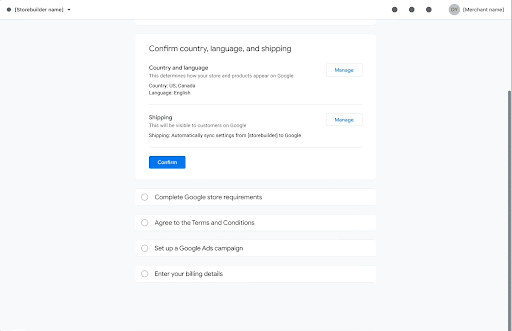لمحة عن هذا الدليل
يهدف هذا الدليل إلى تزويد صنّاع المتاجر بمجموعة من أفضل ممارسات الدمج للبيانات المجانية والإعلانات المدفوعة. يساعد هذا الدليل شركات إنشاء المتاجر على تمكين التجار من خلال تقديم تجربة سلسة. يُلقي هذا الدليل الضوء على مختلف واجهات Google APIs المطلوبة لإدارة عدد كبير من حسابات Merchant Center و"إعلانات Google" بكفاءة. أثناء التنقل في الدليل، يمكنك توقّع العثور على الإرشادات التالية لمعظم الأقسام:
- المقدمة وتأثير الأعمال
- إرشادات التكنولوجيا (واجهة برمجة التطبيقات وغيرها)
- إرشادات حول تجربة المستخدم مع لقطات شاشة
- النصائح والمشاكل المعروفة
كيفية استخدام هذا الدليل
أثناء تنقلك في هذا المورد، تجد 5 خطوات أوسع لإنشاء تكامل أساسي قوي:
- إعداد الحساب
- تحميل المنتجات
- جودة البيانات / استكشاف الأخطاء وإصلاحها
- الإعلانات
- إعداد التقارير
لكل خطوة من هذه الخطوات، هناك ميزات أساسية يجب تنفيذها. فمعظم الميزات مطلوبة ولكن بعضها ليس مطلوبًا استنادًا إلى عدة عوامل. ويتمّ تحديد هذه الاشتراكات بالاستناد إلى موقعك الجغرافي، والمكان الذي يستهدفه التجّار، والطريقة التي تقرّر بها التنفيذ، فضلاً عن برامج التسوّق التي تطبّقها.
مبادئ توجيه تصميم تجربة المستخدم للإعداد
من المهم تقديم تجربة إعداد ترشد تجّار منصات إنشاء المتاجر الذين يرغبون في عرض منتجاتهم على Google، وإعدادهم للنجاح في البداية من خلال منع حدوث أخطاء يمكن تجنُّبها.
ننصح بتجربة "تجربة المستخدم" لتوحيد متطلبات إعداد البيانات المجانية والإعلانات المدفوعة وتوفير خطوات اختيارية بشأن الإعلانات المدفوعة عند الحاجة (أي إنشاء إعلانات مدفوعة، بما في ذلك "إعداد حملة على "إعلانات Google" وإدخال تفاصيل الفوترة).
هناك 3 مبادئ محددة لتجربة المستخدم للتأهيل نقترح أن تكون على دراية بها أثناء تصميم الدمج.
عملية إعداد الأجهزة الأساسية بسهولة
ننصح التجّار بما يلي لمساعدة التجّار في الانضمام بسهولة:
تبسيط الإعداد: ننصحك بتوفير الحدّ الأدنى من المهام الإلزامية فقط.
الإعدادات التلقائية الذكية وقابلة للتعديل دائمًا: عند ضبط الإعدادات، عليك إجراء تخمين مدروس بالنيابة عن التجّار، وكن واضحًا بشأن هذا الخيار واسمح لهم بتعديله.
إعداد صفحة واحدة: من أفضل الممارسات أن تكون جميع مهام الإعداد في صفحة واحدة. يمكن للتجّار الاطّلاع على جميع المهام معًا عند بدء عملية الإعداد، وفي أي مرحلة من مراحل عملية الإعداد.
السماح للتجّار بإكمال المهام المعقّدة لاحقًا: للتحقّق من سياسة الموقع الإلكتروني وإعدادات الشحن، اسمح للتجّار بالتخطّي أثناء عملية الإعداد وإكمالها في وقت لاحق، راجِع المعلومات. بعد ذلك، قم بتنبيه التجار وإرشادهم لإكمال المتطلبات بعد الإعداد.
الإرشادات السياقية
ننصح بتوجيه التجّار لفهم تأثير مهام الإعداد وعرض إرشادات موجزة فقط عندما تكون مرتبطة بالمهمة الحالية التي يعمل عليها التجّار.
القدرة على التكيّف
تُقدِّم الإرشادات تصنيفًا ويمكن أن تنفتح أثناء تطبيقها على مجموعة متنوعة من أدوات إنشاء المتاجر. وننصحك بالتكيّف بناءً على عملية الدمج، ويمكنك تحديد الخيار الذي يناسب حالة النظام الأساسي على أفضل وجه. على سبيل المثال، هناك إعدادات شحن لمنصات إنشاء المتاجر ذات الموارد المفتوحة ومنصات إنشاء المتاجر باستخدام نظام شحن قوي.

التواصل مع القنوات
إذا كانت لديك أي أسئلة أو كنت بحاجة إلى الدعم، يُرجى استخدام الخيارات التالية:
فريق دعم Content API for Shopping: للحصول على الدعم الفني، يمكنك التواصل مع فريق دعم Content API for Shopping.
فريق دعم Google Merchant Center: تساعدك قناة الدعم هذه في الحصول على دعم للإجابة عن أسئلتك المتعلقة بـ Merchant Center والإعلانات المدفوعة.
جهة التواصل في Google: إذا كان لديك جهة التواصل المعيّنة لك في Google لدعم عملية الدمج، ننصحك بالتواصل معها مباشرةً لطرح أي أسئلة.
